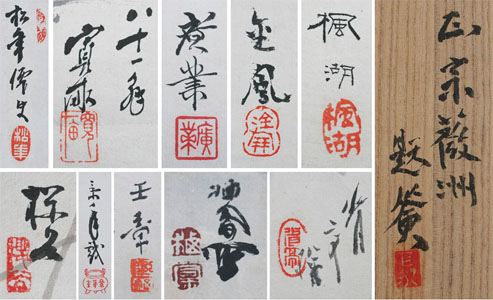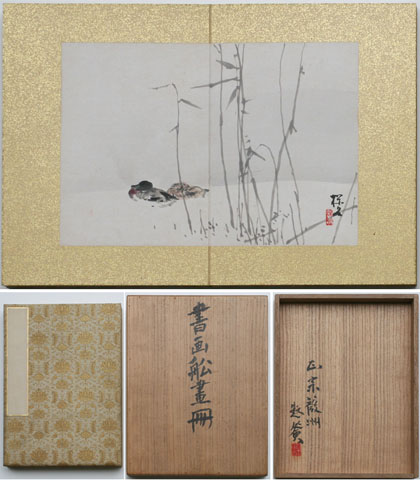Nihonga
Shoga senga, Gajô / Miscellaneous subjects,Signed:
Seals:
Technique: sumi and colours on paper 22,8 x 16,5
Date: 1910s
Box: signed by the Western-style painter and author on Tessai Masamune Tokusaburō (1883-1962) (Rob. p. 103)
Condition: fine
1 Suzuki Shônen (1849-1918) 鈴木松年 - Ariwara no Narihira with Mount Fuji
[Sign:] 松年僊史「印」松年 Shônen Senshi [Seal:] Shônen & unread (tp)
Shônen’s life-style is reflected in his paintings: bold and full of self-confidence.
Shônen had many important patrons to support him, and as a result he became an important painter in Kyoto. He was the son and pupil of the Kyoto Shijô artist Suzuki Hyakunen (1825-91). At a very early age he already achieved great skill and worked in a spontaneous, bold and impromptu manner. In 1881 he succeeded Konô Bairei (1844-95) at the Kyoto Art Academy, teaching Northern Chinese painting until 1888. In 1886 he also started teaching at the Kyoto Prefectural School of Painting, the same school he had attended as a pupil. In his later years Shônen became an extremely influential person in Kyoto art circles.
2 Araki Kampô (1831-1915) 荒木寛畝 - Geese (81 years old) (1911)
[Sign:] 八十一翁寛畝 「印」寛畝 Hachjûichi ô Kampô [Seal:] Kampô
Kampo was born in Edo, lived in Tokyo. He was a student of Araki Kankai (1789-1860) who adopted him. For a short while he studied Western style painting, but returned to his original style. An important artist in the cultural world of Tokyo. Professor at the School of fine Arts and ean xhibitor and a winner of prizes at the Bunten and as well as internationally.
3 Terazaki Kôgyô (1866-1919) 寺崎廣業 - Portrait of ..
[Sign/seal:] 廣業 Kôgyô
At the end of Meiji period and in early Taishô Kôgyô was an important Nihonga painter in Tokyo. He was one of the founders of the Japan Art Institute, the Nihon Bijutsu-in, and was involved in a number of other important institutions. He also taught at the Tokyô School of Fine Arts.
Kôgyô was born in Akita and went to Tokyo in 1888 to study a variety of styles, Chinese as well as Japanese. From this mixture he created his own rather eclectic manner.
4 Mochizuki Kimpô (1846-1915) 望月金鳳 - Sparrows
[Sign/seal:] 金鳳 Kimpô
Kimpô was born in Osaka. At first he studied Maruyama painting. Later he continued his studies with Shijô-painting under Nishiyama Kan'ei (1833-1897).
After a short while in Sapporo he went to Tokyo in 1890 to establish himself as an independant artist. He showed with several official exhibition groups during the early Meiji era; as from 1908 he served as juror for the Bunten. He was specialized in paintings of foxes and badgers.
5 Konoshima Ôkok,(1877-1938) 木島櫻谷 - Pair of ducks
[Sign:/seal: 櫻谷 Ôkoku
Ôkoku is known as a delicate, sensitive painter of kachôga (bird and flower painting), and landscapes. He was a rather independent artist, who remained true to his own high standards and who didn’t allow himself to be influenced by fashion. But in the end his independence made him lonely.
Ôkoku studied painting with Imao Keinen (1845-1924) and Chinese classics with the Confucian scholar Yamamoto Keigu (1827-1903). In his early career he was a successful artist, a frequent winner of prizes at the Bunten; and from 1913 on an adjudicator for both Bunten and Teiten, official government-sponsored exhibitions. During his later years, though, he felt unrecognized and turned to poetry and calligraphy.
6 Matsumoto Fûko (1840-1923) 松本楓湖 - Portrait of ..
[Sign/seal:] 楓湖 Fûko
Fûko successfully followed the line of Kikuchi Yôsai (1788-1878).
Fûko came to the studio of Yôsai after his education with Oki Ichiga (1798-1855) and Satake Eikai (1803-1874). When grown to maturity he specialized in historical subjects and he became a member of the Imperial Fine Arts Academy and a juror for the first four exhibitions of the Bunten.
7 Kawabata Gyokushô (1842-1913) 川端玉章 - Landscape
[Sign: ]玉章「印」玉章子文 Gyokushô [Seal:] Gyokushô Shibun
Gyokushô was born in Kyôto, the son of a lacquer worker. He studied Shijô style painting with Nakajima Raishô (1796-1871) and Nanga painting with Oda Kaisen (1785-1862) for a very short while. To study Western painting under Charles Wirgman (1832-1891) and Takahashi Yuichi (1828-1894) he left for Tokyo in 1866. But before long he returned to the Shijô-style. In 1889 he became a professor at the Tokyo School of Fine Arts and with Kanô Hôgai (1828-1888) and Hashimoto Gahô (1835-1908) and a leading figure in Tokyo art circles.
8 Imao Keinen (1845-1924) 今尾景年 - Scarecrow
[Sign:] 景年戯「印」景年主 Keinen gi [Seal:] Keinen sei
Imao Keinen studied under Suzuki Hyakunen (1825-1891). During the uprisings marking the end of the Tokugawa regime the Imao house was destroyed. Released from his family's business he was able to devote all his time to art and he established his own studio in 1868 where he trained many students. In 1888 he started teaching at the Kyôto Art Academy. He was a dedicated teacher, who always took much effort and was greatly concerned with the progress of his pupils.
9 Takeuchi Seihô (1864-1942) 竹内栖鳳 - Wet landscape
[Sign:] 栖鳳写「印」栖鳳 Seihjô sha [Seal:] Seihô
Seihô was an extremely skilful painter, which earned him fame and a lot of pupils. He entered Bairei's studio at the age of 16 and already the following year he won his first prize at an exhibition, which is a rare for such a young artist.
He eagerly studied all different styles. In 1900 he went to Europe for six months to get acquainted with western painting. On his return he changed the first character "Sei" of his name into a character meaning "West". His two trips to China in 1920 and 1921 meant another enrichment to his painting. His flexibility in styles and the flamboyantly virtuoso way he handled his brush meant in the eyes of some critics that his craftsmanship reduced his artistic abilities.
10 Watanabe Seitei (1851-1918) 渡辺省亭 - Crows in the snow
[Sign/seal:] 省亭 Seitei
Box: Signed: 正宗薇洲題簽 Masamune Bishû Daisen seal: unread
Price: SOLD

